ECU PONTIAC GRAND PRIX 2003 Owners Manual
[x] Cancel search | Manufacturer: PONTIAC, Model Year: 2003, Model line: GRAND PRIX, Model: PONTIAC GRAND PRIX 2003Pages: 378, PDF Size: 17.64 MB
Page 6 of 378
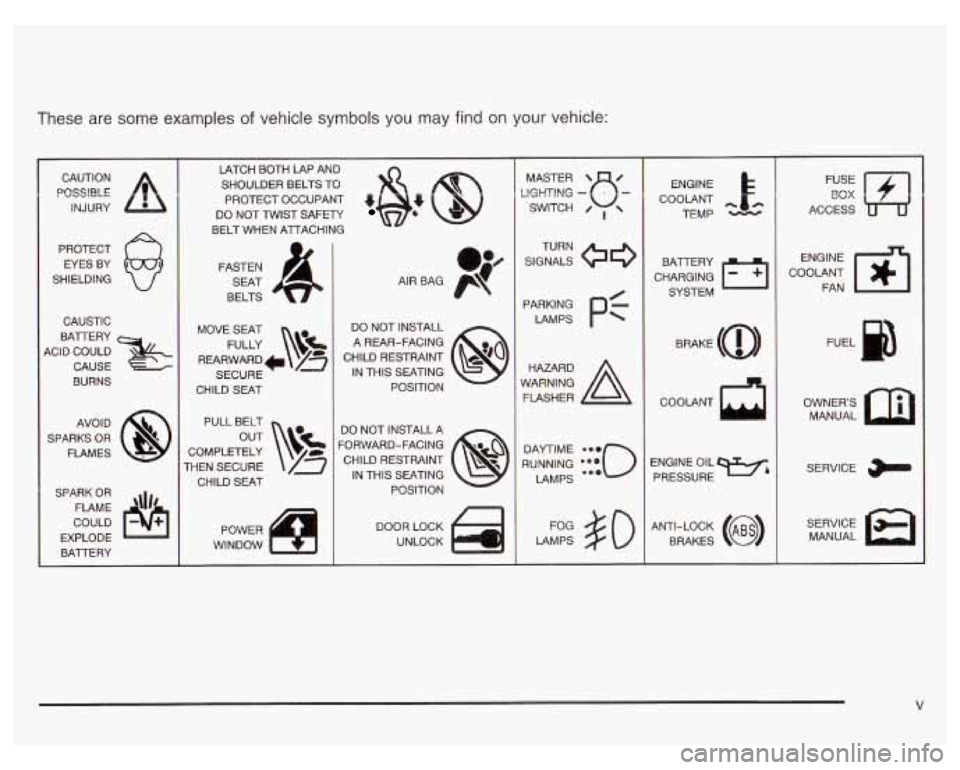
These are some examples of vehicle symbols you may find on your vehicle:
POSSlBLE A
CAUTION
INJURY
PROTECT EYES BY
SHIELDING
CAUSTIC
BAlTERY
4CID COULD CAUSE
BURNS
AVO1
D
SPARKS OR
FLAMES
SPARK OR FLAME
\\I/'
COULD
EXPLODE BAlTERY LATCH BOTH LAP AND
SHOULDER BELTS
TO
PROTECT OCCUPANT 4
DO NOT TWIST SAFETY
BELT WHEN AlTACHING
FASTEN SEAT
BELTS
MOVE SEAT FULLY
\!$%
REARWARD* /z
SECURE
CHILD SEAT
PULL BELT
COMPLETELY
THEN SECURE CHILD SEAT
TI POWER
WINDOW DO NOT INSTALL
A REAR-FACING
CHILD RESTRAINT IN THIS SEATING POSITION
DO NOT INSTALL A
'ORWARD-FACING CHILD RESTRAINT IN THIS SEATING
POSITION
DOOR LOCK
UNLOCK
L
LlGHTlNG - MASTER SWITCH e- / ,
SIGNALS TURN
PARKING
pf
LAMPS
RUNNING LAMPS
LAMPS
so
ENGINE
COOLANT TEMP
CHARGING BAlTERY
SYSTEM
COOLANT
d
ENGINE OIL PRESSURE
Wb
ANTI-LOCK (@)
BRAKES ENGINE
COOLANT FAN
OWNERS MANUAL
SERVICE
MANUAL
Page 8 of 378
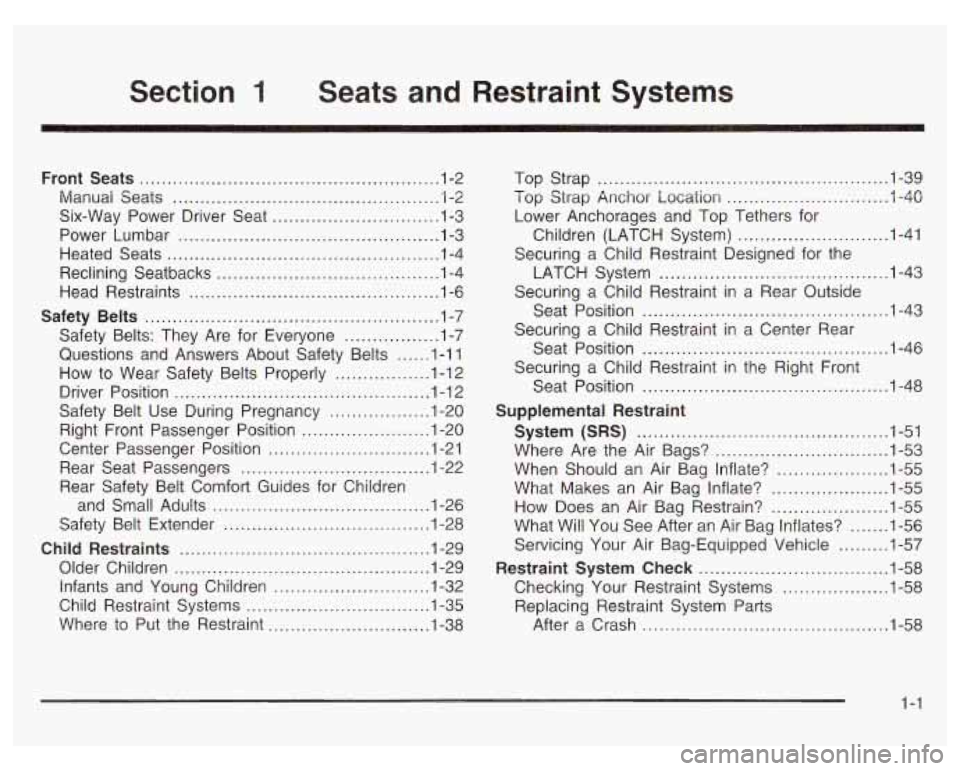
Section 1 Seats and Restraint Systems
Front Seats ...................................................... 1.2
Manual Seats
................................................ 1.2
Six-Way Power Driver Seat .............................. 1-3
Power Lumbar
............................................... 1-3
Heated Seats
................................................. 1-4
Head Restraints
............................................. 1-6
Safety Belts: They Are for Everyone
................. 1-7
Questions and Answers About Safety Belts
...... 1.11
How to Wear Safety Belts Properly
................. 1.12
Driver Position
.............................................. 1.1 2
Safety Belt Use During Pregnancy
.................. 1-20
Reclining
Seatbacks
........................................ 1-4
Safety Belts ..................................................... 1-7
Right Front Passenger Position
....................... 1-20
Center Passenger Position
............................. 1-21
Rear Seat Passengers .................................. 1-22
Rear Safety Belt Comfort Guides for Children
and Small Adults
....................................... 1.26
Safety Belt Extender
..................................... 1-28
Child Restraints ............................................. 1.29
Older Children
.............................................. 1-29
Infants and Young Children
............................ 1.32
Child Restraint Systems
................................. 1-35
Where to Put the Restraint
............................. 1-38 Top
Strap
.................................................... 1.39
Top Strap Anchor Location
............................. 1.40
Lower Anchorages and Top Tethers for
Children (LATCH System)
........................... 1.41
Securing a Child Restraint Designed for the
LATCH System
......................................... 1-43
Securing a Child Restraint in
a Rear Outside
Seat Position
............................................ 1.43
Securing a Child Restraint in a Center Rear
Seat Position
............................................ 1-46
Securing a Child Restraint in the Right Front
Seat Position
............................................ 1.48
Supplemental Restraint
System (SRS)
............................................. 1-51
Where Are the Air Bags?
............................... 1-53
When Should an Air Bag Inflate?
.................... 1-55
What Makes an Air Bag Inflate?
..................... 1-55
How Does an Air Bag Restrain?
..................... 1-55
What Will You See After an Air Bag Inflates?
....... 1.56
Servicing Your Air Bag-Equipped Vehicle
......... 1-57
Checking Your Restraint Systems ................... 1.58
Replacing Restraint System Parts
After a Crash
........................................ 1-58
Restraint System Check .................................. 1-58
Page 20 of 378

Make sure the release button on the buckle is
positioned
so you would be able to unbuckle the
safety belt quickly
if you ever had to.
3. Pick up the latch plate and pull the belt across you.
Don’t let it get twisted.
The shoulder belt may lock
if you pull the belt
across you very quickly.
If this happens, let the belt
go back slightly to unlock it. Then pull the belt
across you more slowly.
4. Push the latch plate into the buckle until it clicks.
Pull up on the latch plate to make sure it is secure.
If
the belt isn’t long enough, see Safety Belt Extender
on page 1-28 at the end of this section.
5. To make the lap part tight, pull down on the buckle
end
of the belt as you pull up on the shoulder belt.
1-13
Page 31 of 378

2. Push the latch plate into the buckle until it clicks.
Pull up on the latch plate to make sure
it is
secure.
When the shoulder belt is pulled out all the way,
it will lock.
If it does, let it go back all the way and
start again.
If the belt is not long enough, see
Safety Belt Extender on page
1-28.
Make sure the release button on the buckle is
positioned
so you would be able to unbuckle the
safety belt quickly if you ever had to.
3. To make the lap part tight, pull down on the buckle
end of the belt as you pull up on the shoulder part.
1-24
Page 40 of 378

For example, in a crash at only 25 mph
(40 km/h), a 12-lb. (5.5 kg) baby will suddenly
become
a 240-lb. (110 kg) force on a person’s
arms.
A baby should be secured in an
appropriate restraint.
-
Children who are up against, or very close to,
any air bag when it inflates can be seriously
injured or killed.
Air bags plus lap-shoulder
belts offer outstanding protection for adults
and older children, but not for young children
and infants. Neither the vehicle’s safety belt
system nor its air bag system is designed for
them. Young children and infants need the
protection that a child restraint system can
provide.
1-33
Page 41 of 378
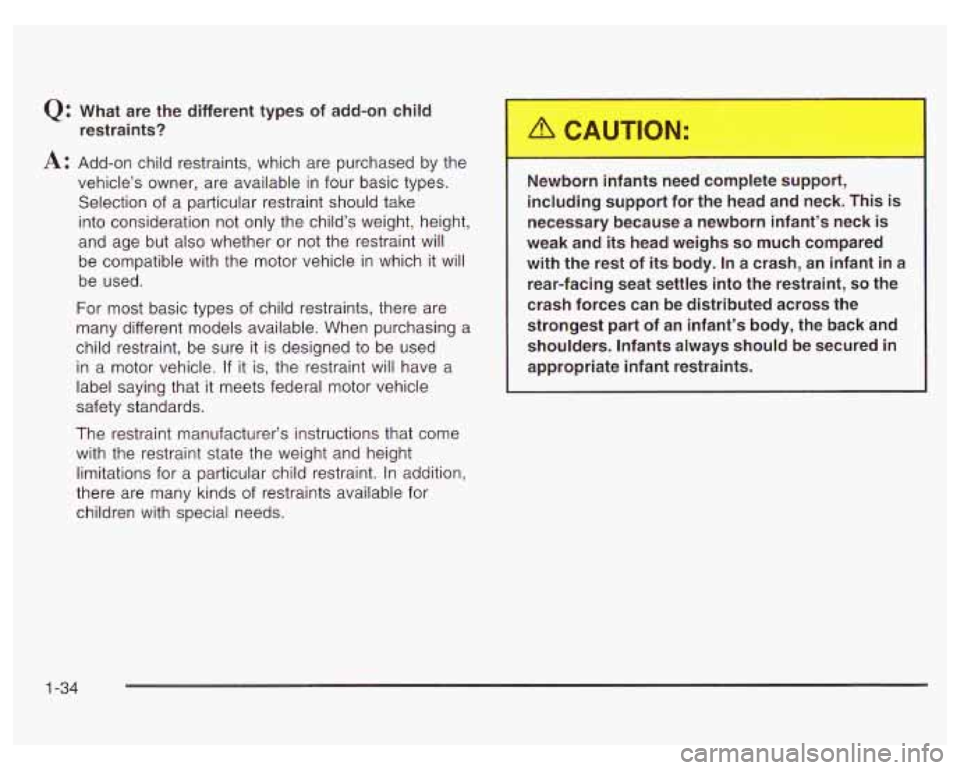
Q: What are the different types of add-on child restraints?
A: Add-on child restraints, which are purchased by the
vehicle’s owner, are available in four basic types.
Selection of a particular restraint should take
into consideration not only the child’s weight, height,
and age but also whether or not the restraint will
be compatible with the motor vehicle in which it will
be used.
For most basic types of child restraints, there are
many different models available. When purchasing a
child restraint, be sure it is designed to be used
in a motor vehicle. If it is, the restraint will have a
label saying that it meets federal motor vehicle
safety standards.
The restraint manufacturer’s instructions that come
with the restraint state the weight and height
limitations for a particular child restraint. In addition,
there are many kinds of restraints available for
children with special needs. Newborn infants
need complete support,
including support for the head and neck. This
is
necessary because a newborn infant’s neck is
weak and its head weighs
so much compared
with the rest of its body.
In a crash, an infant in a
rear-facing seat settles into the restraint,
so the
crash forces can be distributed across the
~ strongest part of an infant’s body, the back and
shoulders. Infants always should be secured in
appropriate infant restraints.
1-34
Page 44 of 378
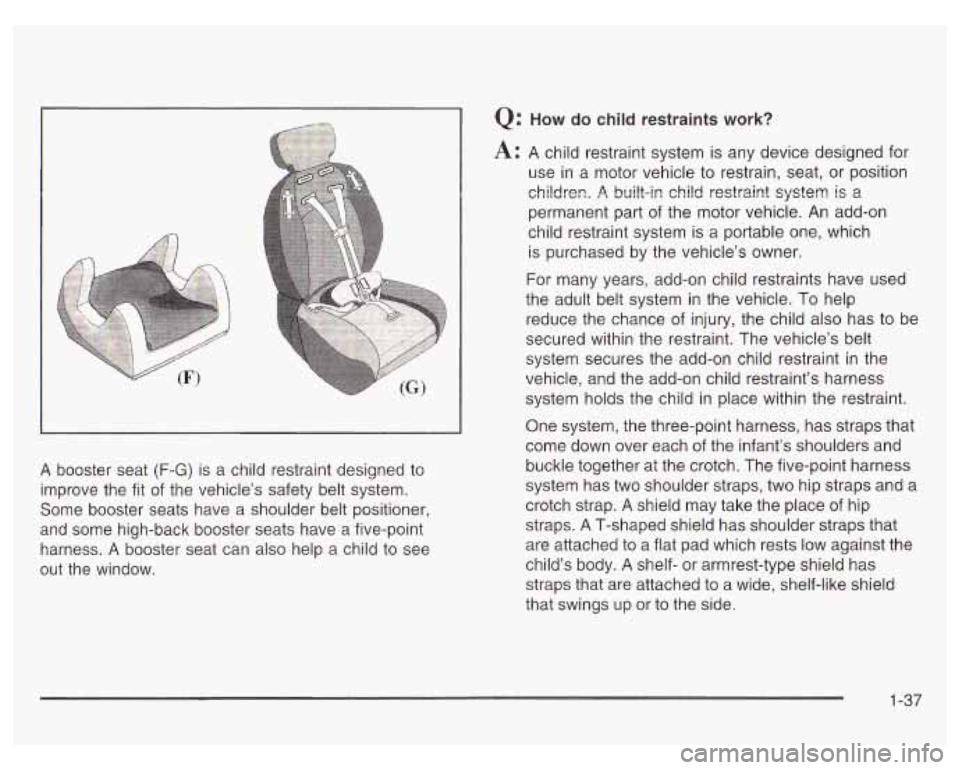
A booster seat (F-G) is a child restraint designed to
improve the fit
of the vehicle’s safety belt system.
Some booster seats have a shoulder belt positioner,
and some high-back booster seats have a five-point
harness.
A booster seat can also help a child to see
out the window.
Q: How do child restraints work?
A: A child restraint system is any device designed for
use in a motor vehicle to restrain, seat, or position
children.
R built-in child restraint system is i!
permanent part of the motor vehicle. An add-on
child restraint system is a portable one, which
is purchased by the vehicle’s owner.
For many years, add-on child restraints have used
the adult belt system in the vehicle. To help
reduce the chance of injury, the child also has to be
secured within the restraint. The vehicle’s belt
system secures the add-on child restraint in the
vehicle, and the add-on child restraint’s harness
system holds the child in place within the restraint.
One system, the three-point harness, has straps that
come down over each of the infant’s shoulders and
buckle together at the crotch. The five-point harness
system has two shoulder straps, two hip straps and a
crotch strap.
A shield may take the place of hip
straps.
A T-shaped shield has shoulder straps that
are attached to a flat pad which rests
low against the
child’s body.
A shelf- or armrest-type shield has
straps that are attached to a wide, shelf-like shield
that swings up or to the side.
1-37
Page 45 of 378

When choosing a child restraint, be sure the child
restraint is designed to be used in a vehicle.
If it is,
it
will have a label saying that it meets federal motor
vehicle safety standards.
Then follow the instructions for the restraint. You may
find these instructions on the restraint itself or in a
booklet, or both. These restraints use the belt system in
your vehicle, but the child also has to be secured
within the restraint to help reduce the chance of personal
injury. When securing an add-on child restraint, refer
to the instructions that come with the restraint which may
be on the restraint itself or in a booklet, or both, and
to this manual. The child restraint instructions are
important,
so if they are not available, obtain a
replacement copy from the manufacturer.
Where to Put the Restraint
Accident statistics show that children are safer if they
are restrained in the rear rather than the front
seat. General Motors, therefore, recommends that child
restraints be secured in a rear seat, including an
infant riding in a rear-facing infant seat, a child riding
in a forward-facing child seat and an older child
riding in a booster seat.
Never put a rear-facing
child restraint
in the front passenger seat. Here’s why:
A cl
f in a rear-facing child restraint can be
seriously injured or killed if
the right front
passenger’s air bag inflates. This is because
the back of the rear-facing child restraint
would be very close to the inflating air bag.
Always secure a rear-facing child restraint in
a rear seat.
You may secure a forward-facing child
restraint in the right front seat, but before you
do, always move the front passenger seat as
far back as
it will go. It’s better to secure the
child restraint
in a rear seat.
Wherever you install it, be sure to secure the child
restraint properly.
Keep in mind that an unsecured child restraint can move
around in a collision or sudden stop and injure people in
the vehicle. Be sure to properly secure any child restraint
in your vehicle
- even when no child is in it.
1-38
Page 47 of 378
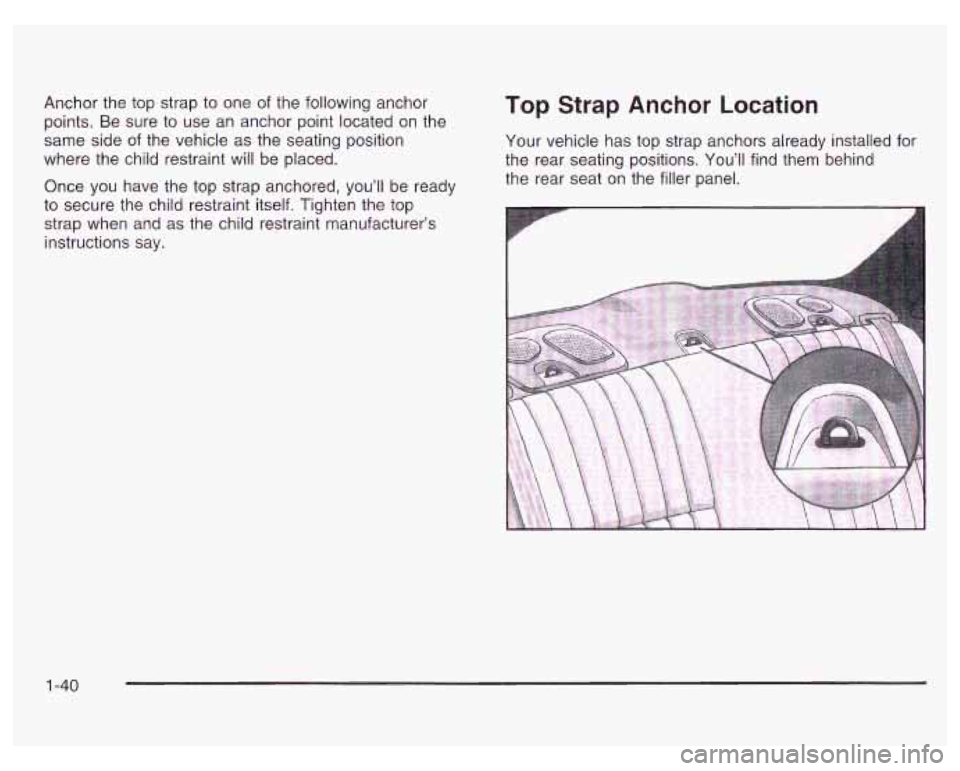
Anchor the top strap to one of the following anchor
points. Be sure to use an anchor point located on the
same side of the vehicle as the seating position
where the child restraint will be placed.
Once you have the top strap anchored, you’ll be ready
to secure the child restraint itself. Tighten the top
strap when and as the child restraint manufacturer’s
instructions say. Top Strap Anchor Location
Your vehicle has top strap anchors already installed for
the rear seating positions. You’ll find them behind
the rear seat on the filler panel.
1-40
Page 49 of 378

L
A. Vehicle anchor
B. LATCH system attachment points
With this system, use the LATCH system instead of the
vehicle’s safety belts
to secure a child restraint.
. - iTC. ‘type chi., restra ____ __ - attachec -3
its anchorage points, the restraint won’t be
able to protect a child sitting there. In a crash,
the child could be seriously injured or killed. Make sure that a LATCH-type child restraint is
properly installed using the anchorage points,
or use the vehicle’s safety belts to secure the
restraint. See “Securing a Child Restraint
Designed for the LATCH System”, “Securing a
Child Restraint in
a Rear Outside Seat
Position” or “Securing a Child Restraint in a
Center Rear Seat Position”
in the Index for
information on how to secure a child restraint
in your vehicle.
1 -42